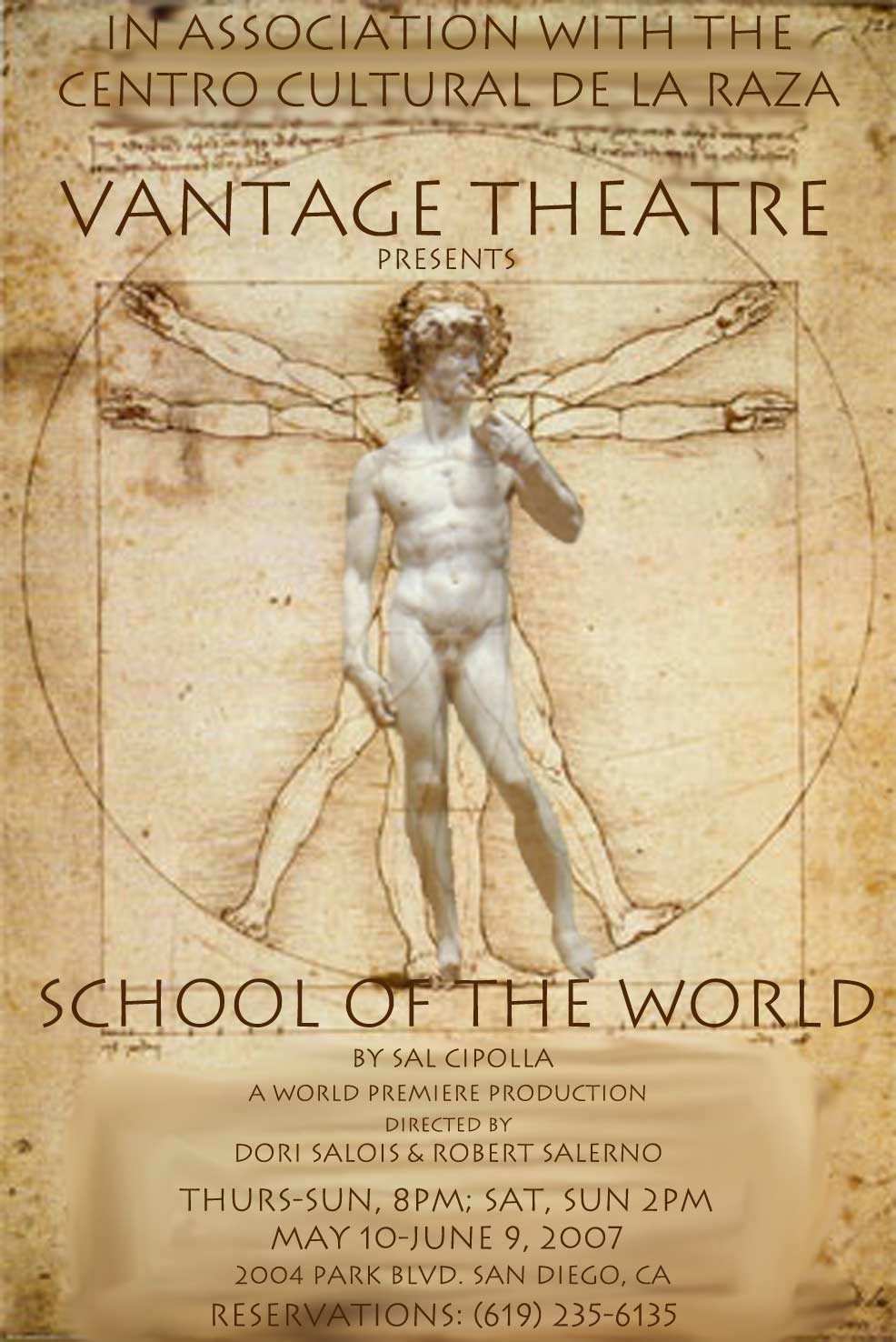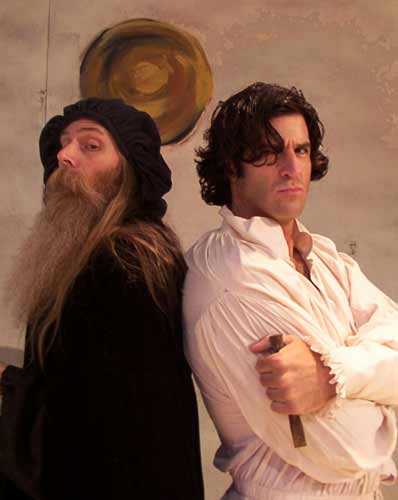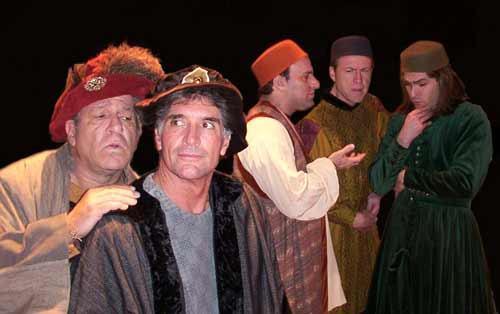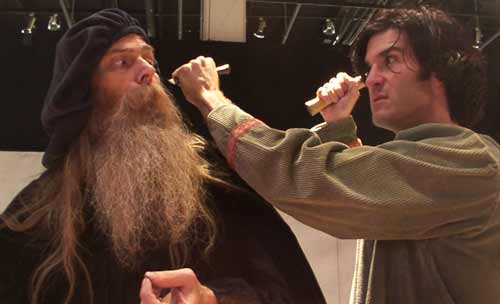 Theatre
From a Different Vantage Point
Theatre
From a Different Vantage Point
REVIEWS
THE PASSION OF THE MASTERS
THE SHOW: The School of the World, a world premiere (and the playwriting debut) of New York musician, film director, comic and sometime actor Sal Cipolla.
THE STORY: It’s an intriguing and irresistible story, partially based
in fact. 1503, Florence, the power-center of social/cultural/political life
during the Italian Renaissance. Two creative geniuses at work in the city
-- the middle-aged Michelangelo Buonarroti and the young prodigy Leonardo
da Vinci -- have bared their teeth repeatedly in a personal and professional
rivalry that has become legendary. Enter Piero Soderini, one haughty, recently
elected Gonfaloniere, or Chief Magistrate, who decides to capitalize on the
famous enmity. He commissions both men to create murals in the Council Hall
of the newly constructed Palazzo Vechhio, the seat of the Florentine government.
And he writes into the contract that they are to work ‘in competition,’
hoping that will entertain the masses by fueling the conflict, and will also
stimulate the creation of two masterpieces that celebrate the military victories
of Florence. It was the first battle scene either master had ever painted.
And neither fresco was ever completed.
This is the foundation for the play; the rest is pure speculation: what happened
during the time they were in the Great Hall together, what they talked about,
how they worked, and why they didn’t finish. Not all of those questions
are answered, and the twosome’s interactions aren’t all that instructive
about their work or their creative process. But the story is delicious, and
its potential to provoke is certainly compelling…
THE PLAYERS: The 21 year-old Vantage Theatre should be commended
for taking on the massive challenge of a new play by a novice playwright,
about two luminaries of the art world and the world at large. To portray these
monumental characters takes actors of depth, breadth and experience. Co-directors
(and life-partners) Dori Salois and Robert Salerno assembled a cast of varied
experience and expertise. Center-stage are the two larger-than-life geniuses;
as Leonardo, James Gary Byrd certainly looks provocative with his scraggly,
waist-length beard, his compulsive notebook-scribbling and his excitement
about his next potential invention... his fawning assistant (slightly dim-witted
as written, and as appealing played by Tyler Jaymes Albright…As Michelangelo,
Jeffrey Lippold is young, attractive, arrogant and pugnacious… The program
notes tell us that “Leonardo was known for the shadowy softness and
ambiguity of his work,” and “Michelangelo was … known for
imbuing his work with a sense of vibrant energy and dynamism.” Jonathan
Dunn-Rankin makes a delightful cameo appearance as the soft-spoken but impatient
and demanding Pope Julius II, and Spike Sorrentino creates an interesting
character in the small role of a naive cleric. Eric George is fine as the
snarling, art-hating Cardinal who’s sent by the Pope to take Michelangelo
away from this project so he can start on “the ceilings.”
THE PRODUCTION: The production is quite attractive. Salerno designed the minimalist set, nicely lit by Sally Stockton. The arched doors and windows and the ornate wood table center-stage amply suggest the Renaissance, as do the colorful and varied costumes (Salois, Jean Moroney and Jodi Brisebois). Each scene is introduced with appropriate music (Salerno’s sound design). Best of all is Salerno’s multimedia creations. His projections on the big blank walls show the evolution of the murals, from studies and sketches to more fully realized work. And when Michelangelo uses Leonardo’s invention to try to escape the Cardinal, we see a man ‘in flight’ projected out a rear window. Magical.
The story is marvelous and the play has considerable potential.
THE LOCATION: Vantage Theatre at the Centro Cultural de la Raza, through June
9
--Pat Launer, KPBS
First-Time Playwright Hits Mark
Vantage Theatre’s new production, “The School of
the World,” takes an intriguing premise and follows through on the scenario’s
potential.
Written by first-time playwright and Poway resident Sal Cipolla, the piece
unites two legendary figures and endows them with fully realized life, with
powerful personalities that are at least rooted in historical fact.
James Gary Byrd’s Leonardo da Vinci is overwhelmingly quirky, a bearded,
long-haired old man given to (purportedly literal) flights of fancy, with
mannerisms that time and again reminded this writer of Johnny Depp’s
Captain Jack Sparrow. He seems unable to focus on painting for long, which
the play suggests is the reason for his completing so few of the works of
art that he began.
Jeffrey Lippold’s Michelangelo, on the other hand, is often brooding
and nearly always serious. He thinks of Leonardo’s scientific and engineering
pursuits as utter foolishness, himself being fully devoted to the creation
of works of art and longing to achieve immortality through his work.
The two clash during a period of confinement in the newly completed Palazzo
Vecchio in Florence, Italy. Both have been commissioned to paint the walls,
with each being assigned one half of the room, and the first to finish his
work is set to receive more payment than the other.
The scenario is taken from real life, but the true events that led to the
murals’ never having been completed remains a mystery.
Leonardo and Michelangelo are famous for their dislike of each other, an important
fact for Cipolla’s take on the story. Early in their prolonged encounter
their exchanges are strictly hostile, so much so that Pietro Soderini (Steve
Oliver), who commissioned the two, paints a line down the middle of the room
and orders them to stay on opposite sides of it.
The script approaches what could have been a rather serious historical drama
with a good deal of comedic sensibility. Leonardo, more than any other character,
is quite humorously drawn.
On one occasion he asks Michelangelo, “When did you become my wife?”
On another he uses a loud whisper to instruct his assistant concerning Michelangelo,
“Pay him no mind; he’s a man of low moral character.”
The best thing that “The School of the World” has going for it
is the basic premise. Who wouldn’t love to spend an evening pretending
to be in close quarters with two giants of the Renaissance whose masterpieces
continue to awe the world to this day?
“The School of the World” plays through June 9, with show times
at 8 p.m. on Thursdays through Sundays. Tickets range from $15 to $20, and
more information can be found at http://home.san.rr.com/vantagetheatre.
-- Michelle Diaz, Pomerado Newspaper Group
The School of the World
Vantage Theatre Company, in association with the Centro Cultural
de la Raza, is currently presenting a world premiere of Sal Cipolla’s
School of the World. Vantage is one of the few companies in San Diego that
is brave enough to produce new theatrical works and should get a sustained
standing ovation on that fact alone.
Playwright Cipolla’s drama is historically drawn from an assignment
provided by Piero Soderini who commissioned Michelangelo and Leonardo (da
Vinci) to create two side-by-side masterpieces depicting victories of the
Florentine government. These commissions were nothing less than a competition,
forcing the two Renaissance artists to better the other.
The Centro Cultural de la Raza provided an expansive stage area for the drama
and Co-Directors Dori Salois and Robert Salerno took fine advantage of the
space, herding their players effectively into and away from the playing field.
A few fine tableau paintings were achieved with cast members..
Both Michelangelo and Leonardo were Italian Renaissance men with multiple
talents (painter, sculptor, architect, writer, engineer, etc.). It would seem
they would have had much in common, including their love of adolescent boys.
James Gary Byrd carried off the mad-scientist/artist of Leonardo well enough…
while Jonathan Dunn-Rankin as Pope Julius and Eric George as Cardinal Fianco
did well enough in their respective religious assignments.
Robert Salerno designed an effective set which allowed for the progress of
the frescoes via multimedia devices that worked quite well. The costume designs
(Salois, Moroney and Brisebois) were appropriately designed and fit the “measure”
of every man on stage. The expansive stage was effectively lit by Sally Stockton…
I would encourage the San Diego Theatre Scene to purchase tickets and support
Vantage Theatre for no other reason than their brave effort to develop new
works.
(School of the World plays through June 9; tickets @ 619-235-6135)
--Cuauhtémoc Q Kish, SD Theatre Scene




